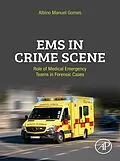EMS in Crime Scene: Role of Medical Emergency Teams in Forensic Cases addresses the different settings that occur in pre-hospital environments, along with the medical-forensic relevance surrounding evidence preservation. The book identifies the main difficulties in this subject to promote proper intervention. The main role of EMS will always be medical assistance, but it is also their job to ensure their safety, the safety of the victim and the protection of the local scene. This means of preserving evidence, even though it is an ancillary activity and is not meant to compromise care of the victim, is an important role of EMS. The objective of preserving where a crime has occurred is, from the outset, to keep the environment as unchanged as possible, that is, not to move and/or subtract objects from their original position (even if it is a firearm) and not to add elements that were not present at the scene, such as shoe trail marks, earth, hair strands, cigarette butts, etc. - Presents how to identify and preserve a crime scene - Covers how to avoid contaminating the victim or crime scene evidence - Reviews how to document the facts in a way that protects both the victim and the medical emergency team
Autorentext
Albino Manuel Gomes is a Forensic Nurse Examiner in APEFORENSE, Lisbon, Portugal.
Klappentext
EMS in Crime Scene: Role of Medical Emergency Teams in Forensic Cases addresses the different settings that occur in pre-hospital environments, along with the medical-forensic relevance surrounding evidence preservation. The book identifies the main difficulties in this subject to promote proper intervention. The main role of EMS will always be medical assistance, but it is also their job to ensure their safety, the safety of the victim and the protection of the local scene. This means of preserving evidence, even though it is an ancillary activity and is not meant to compromise care of the victim, is an important role of EMS.
The objective of preserving where a crime has occurred is, from the outset, to keep the environment as unchanged as possible, that is, not to move and/or subtract objects from their original position (even if it is a firearm) and not to add elements that were not present at the scene, such as shoe trail marks, earth, hair strands, cigarette butts, etc.
- Presents how to identify and preserve a crime scene
- Covers how to avoid contaminating the victim or crime scene evidence
- Reviews how to document the facts in a way that protects both the victim and the medical emergency team
Inhalt
Introduction
Chapter 1 Emergency and urgency: concepts and evolution
Chapter 2 Criminal investigation historical aspects
Chapter 3 Physiopathology of death
Chapter 4 Violent death
Chapter 5 Violent death in emergency department and prehospital
Chapter 6 Evidences with medical-legal relevance
Chapter 7 Crime scene
Chapter 8 Criminal investigation
Chapter 9 Intervention protocols
Chapter 10 Intervention in the preservation and collection of evidences
Chapter 11 Forensic artifacts
Chapter 12 911 call center
Chapter 13 Documentation in forensic cases
Chapter 14 Intra- and extra-hospital material for preservation and collection of evidences
Chapter 15 Final considerations
